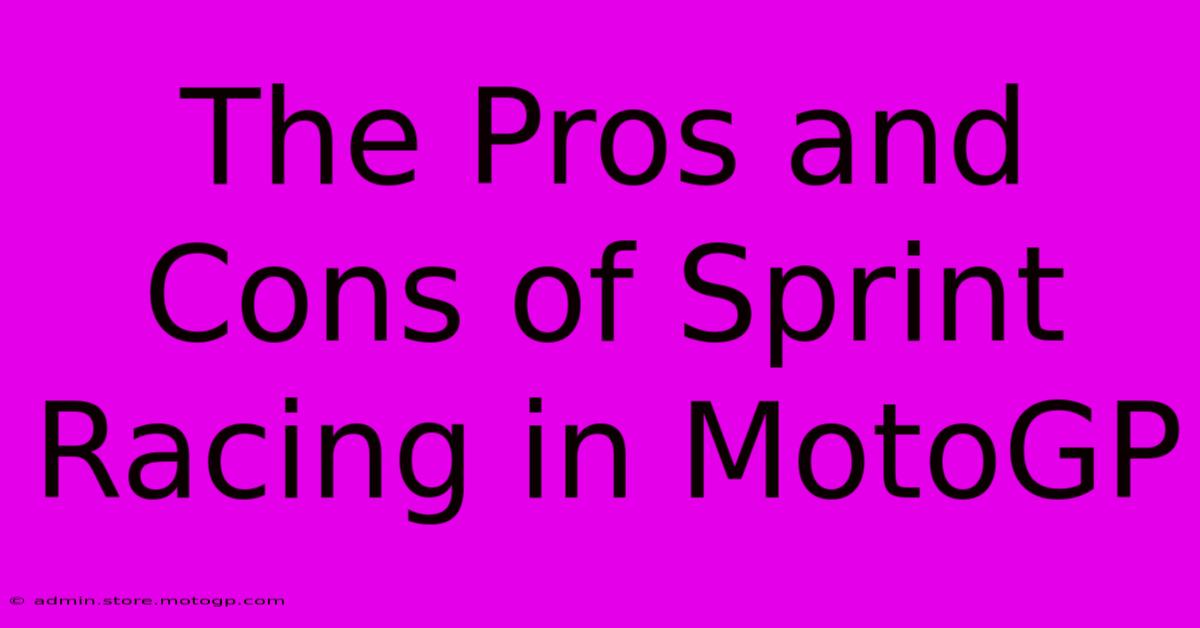The Pros And Cons Of Sprint Racing In MotoGP

Table of Contents
The Pros and Cons of Sprint Races in MotoGP
MotoGP, the pinnacle of motorcycle racing, has embraced a new format: sprint races. Introduced in 2023, these shorter, faster races held on Saturday have injected a new level of excitement and unpredictability into the sport, but they haven't been without their critics. This article will delve into the pros and cons of sprint races in MotoGP, exploring their impact on the championship, the riders, and the overall fan experience.
The Pros: More Action, More Excitement, and Increased Viewership
The most significant advantage of sprint races is the increased excitement and action. The shorter distance means less time for strategy and more emphasis on raw speed and overtaking. This leads to more thrilling races, packed with close battles and dramatic last-lap passes. This is a major draw for casual viewers and helps engage a wider audience.
Increased Viewership and Fan Engagement:
The introduction of sprint races has demonstrably boosted viewership figures. More races mean more opportunities for fans to engage with their favorite riders and teams. The Saturday sprint race provides a second dose of adrenaline, effectively creating a MotoGP 'weekend' instead of just a Sunday event. This increased frequency of action contributes directly to higher viewership and engagement.
More Opportunities for Points and Championship Impact:
Sprint races offer riders additional opportunities to score championship points. This can significantly impact the overall standings, creating more intrigue and competition throughout the season. A strong performance in the sprint can build momentum and confidence going into the main race on Sunday, potentially altering the course of the championship fight.
Added Value for Sponsors:
The increased exposure and viewership translate to increased value for sponsors. More racing means more opportunities for brand visibility, making MotoGP a more attractive proposition for commercial partners. This increased revenue stream could ultimately benefit the sport as a whole.
The Cons: Increased Risk, Rider Fatigue, and Potential for Diminished Main Race Significance
While sprint races offer numerous benefits, they also present several challenges. The biggest concern revolves around rider fatigue and increased risk of injury. Competing in two races within a single weekend puts a significant physical and mental strain on the riders, potentially leading to increased exhaustion and a higher chance of accidents.
Rider Exhaustion and Increased Risk of Injury:
The back-to-back races pose a substantial physical toll. The intense concentration and physical exertion required in each race can lead to rider fatigue, potentially impacting performance and increasing the risk of mistakes and crashes. This poses a significant concern for rider safety and well-being.
Potential for Diminished Main Race Significance:
Some argue that sprint races might diminish the importance of the main Grand Prix. If a rider secures a strong lead in the sprint, they might adopt a more conservative strategy in the main race, leading to a less exciting and potentially predictable outcome. This could ultimately detract from the prestige and drama of the Sunday race.
Cost Implications and Increased Logistics:
Introducing sprint races adds to the overall logistical complexities and cost of running a MotoGP weekend. Teams require more personnel, spare parts, and resources to manage two races instead of one. This increased financial burden might disproportionately impact smaller teams.
Conclusion: A Balancing Act
The introduction of sprint races in MotoGP has undoubtedly added excitement and increased viewership. However, concerns regarding rider fatigue, safety, and the potential impact on the main race remain valid. The future success of this format hinges on finding a balance between enhancing the entertainment value and ensuring the well-being of the riders. Careful monitoring of rider performance, data analysis, and open communication between stakeholders will be crucial to determining the long-term viability and effectiveness of sprint races in MotoGP. Only time will tell if the benefits outweigh the drawbacks.

Thank you for visiting our website wich cover about The Pros And Cons Of Sprint Racing In MotoGP. We hope the information provided has been useful to you. Feel free to contact us if you have any questions or need further assistance. See you next time and dont miss to bookmark.
Featured Posts
-
Speed Moto Gp The Smell Of Burning Rubber
Feb 18, 2025
-
Moto Gp Sprint Race More Action Than Ever Before
Feb 18, 2025
-
Us Gp Concerts Party Like A Rockstar
Feb 18, 2025
-
Moto Gp Live The Dream With Tnt Sports
Feb 18, 2025
-
Cota Store The Must Visit Destination For Racing Fans
Feb 18, 2025
